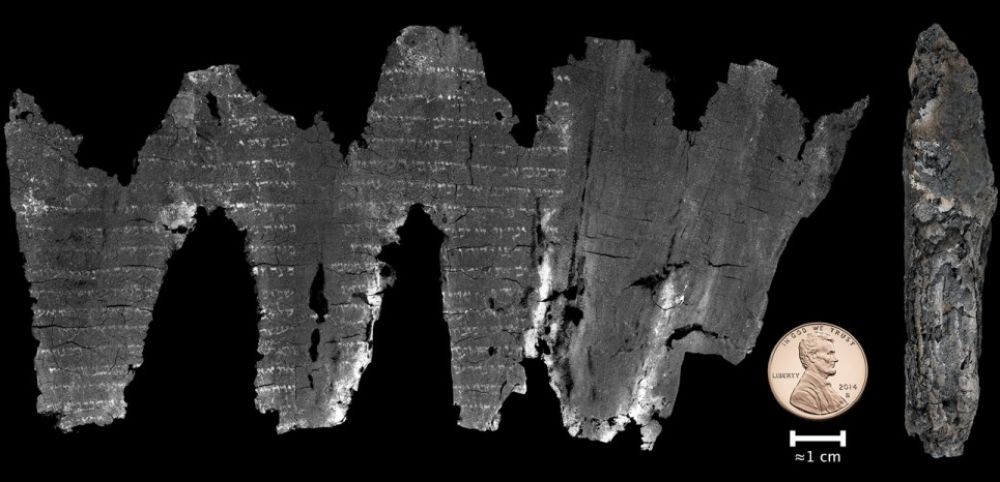 The virtual unrolling of the En-Gedi manuscript.
The virtual unrolling of the En-Gedi manuscript. A new 3D digital imaging technique has revealed the oldest version of an Old Testament manuscript, dating back at least fifteen centuries. This document is too damaged and fragile to be unrolled. Its virtual unwinding thus opens a new window on the past and its secrets. An American-Israeli research team was able to determine that this document, made of animal skin, was the oldest version of Leviticus, the third of the five books of Moses, the Torah, of which it contains the first two chapters. Their discovery, already announced in July 2015, is published on Wednesday September 21, 2016 in the American scientific journal Science Advances . These American and Israeli researchers were able to virtually produce an image of the fully unrolled document, showing 35 lines of text in each column, of which 18 were preserved and 17 were reconstructed.
The scroll was discovered in 1970 in Ein-Gedi
The manuscript was unearthed in 1970 during excavation work at the Ein-Gedi Synagogue in Israel, near the western shore of the Dead Sea. The entire main structure of the document was burned and crushed and continued to disintegrate each time it was touched, the researchers explain. Reading the Ein-Gedi manuscript, “we were struck by the fact that certain passages are identical in calligraphic detail and sectional organization to the Masoretic text, which is authoritative within Judaism,” explained, during a telephone press conference, Michael Segal, director of the faculty of Philosophy and Religion at the Hebrew University of Jerusalem. But this document "doesn't tell us how the original text was" , he specified. The expert points out that this version of the two chapters of the third book of Leviticus of Ein-Gedi "represents the most complete and significant biblical text of antiquity unearthed" since the discovery of the Dead Sea Scrolls.
The Masoreticus is a medieval document that was used by Jews in Europe and this discovery “tells us that Jews used it before that in the land of Israel as well” , noted Emanuel Tov, a professor at the Hebrew University in Jerusalem, co-author of the discovery. To be able to read inside the manuscript these scientists used an advanced digital tomography, a 3D scanner, which was able to detect the traces of metal contained in the ink and the texture of the document. "We were very surprised at the quality of these images" , pointed out Professor Segal."Most of the text is legible or at least nearly as legible as those of the preserved Dead Sea Scrolls" , he added.
These manuscripts consist of several parchments and papyrus fragments mostly in Hebrew, but also in Greek and Aramaic discovered between 1947 and 1956 near Qumran, which was then in the West Bank. Most have not been deciphered and these researchers hope that this new imaging technique will reveal their secrets. "These works open a new window allowing us to go back in time by reading documents that we thought were lost due to their poor state of preservation" , explained Brent Seales, professor of computer science at the University of Kentucky, one of the main authors of this work. "There are so many other unique and fascinating manuscripts that could thus reveal their secrets" , he pointed out, citing in particular the charred papyri of Herculaneum, during an eruption of Vesuvius 79 years before our era. These documents were found in a villa that would have belonged to the father-in-law of Julius Caesar. This technology could also have applications in forensic medicine and in the intelligence sector, according to these scientists.
